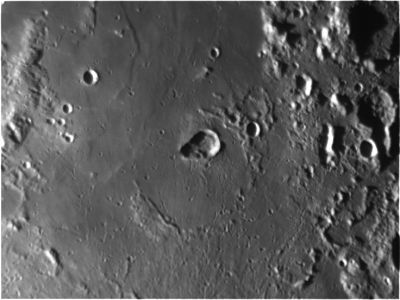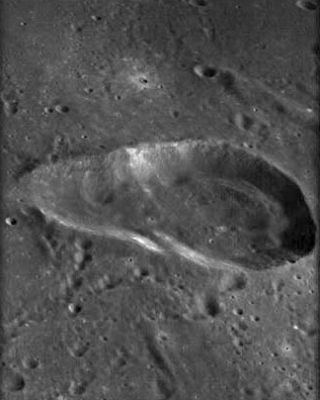Torricelli
Contents
Torricelli
|
Lat: 4.6°S, Long: 28.5°E, Diam: 22 km, Depth: 2.5 km, Rükl: 47 | |
| Elias Chasiotis; click image for larger view. |
AS16-P-4525; enlargement |
Images
LPOD Photo Gallery Lunar Orbiter Images Apollo Images
- Luna 22 photo of Torricelli and its environs. Torricelli itself is located near the panoramic frame's right margin (scroll to the right).
- A small Concentric Crater (number 5 in C.A.Wood's list of 1978) was discovered at the southwestern part of the large ring Torricelli R. This CC is noticeable on the Hi-Res scan of Lunar Orbiter 4 photograph LOIV-77-h3(the CC's location is just above the start of the "crackled appearance" of the "disturbing white line crossing the lower half of the photograph").
- Bowl-shaped crater Torricelli C and NASA's Thud Ridge are detectable near the mountainous horizon in Apollo 10's AS10-29-4300.
- Torricelli C was also captured near the right margins of Apollo 16's panoramic ITEK frames AS16-P-5296 and 5301 (note the nearby Thud Ridge).
- Research Luna 22, LO-IV, Apollo 10, and Apollo 16 photographs: Danny Caes
Maps
(LAC zone 78B3) LAC map Geologic map LM map AIC map LTO map
Description
Description: Elger
(IAU Directions) TORRICELLI.--A remarkable little formation in the Mare Tranquillitatis, N. of Theophilus, consisting of two unequal contiguous craters ranging from E. to W., whose partition wall has nearly disappeared, so that, under a low sun, when the interior of both is filled with shadow, the pair resemble the head of a javelin. The larger, eastern, ring is about 10 miles in diameter, and the other about half this size. There is a gap in the E. wall of the first, and a long spur projecting from its S. side; and a minute crater on the S. border of the smaller object. Torricelli is partially enclosed on the S. by a circular arrangement of ridges. There is a delicate cleft running in a meridional direction on the Mare, W. of the formation, and another on the N., running from E. to W.
Description: Wikipedia
Additional Information
- Depth data from Kurt Fisher database
Pike, 1976: 2.5 km
Westfall, 2000: 2.5 km
Viscardy, 1985: 2.1 km
Cherrington, 1969: 2.1 km - Torricelli and its satellite craters B, C, F, H, K and L are on the ALPO list of bright ray craters
- Torricelli and Torricelli B & C are thermal anomaly craters, implying youthful ages - Moore et al, 1980
- Torricelli A: Oblique impact crater with widening of cross-range direction suggest impact angle of 15° (Forsberg, Herrick & Bussey, 2008).
- Small Concentric Crater (CC) at the southwestern part of the large ring Torricelli R.
The strange lightbluish appearance of Torricelli B (January the 29th, 1983)
- Torricelli B, a small bowl-shaped crater north-northeast of Torricelli, was once the location of a possible Transient Lunar Phenomenon. During the night of January the 29th, 1983, several British observers noticed a rare lightbluish glow at and near that craterlet. Two orbital panoramic Itek-photographs, made during the mission of Apollo 16 in april 1972, show Torricelli B's appearance during high sun illumination. Note the fan-like system of bright bands on the inner slope of that craterlet: AS16-P-5293 and AS16-P-5288 (scroll to the righthand parts of both photographs). Research: Danny Caes
- During Full Moon, some sort of steel-blue/grey "halo" is noticeable around Torricelli B, which creates a contrasting color effect when it is observed together with the slightly yellowish Torricelli itself.- DannyCaes Nov 3, 2009
- The curious high-albedo streaks on Torricelli B's inner slopes could be investigated via the LRO's extraordinary close-ups of that crater at LON: 29.20, LAT -2.64 (ACT-REACT Quick Map).- DannyCaes Jun 18, 2011
Nomenclature
- Named for Evangelista Torricelli (October 15, 1608 – October 25, 1647) an Italian physicist and mathematician, best known for his invention of the barometer. This discovery has perpetuated his fame, and the torr, a unit of pressure, was named in his honor. He also designed and built a number of telescopes and simple microscopes. Although Galileo invited Torricelli to visit, he did not accept until just three months before Galileo's death. During his stay, however, he wrote out Galileo's Discourse of the Fifth day.
- Van Langren seems to have called this crater Wassenarii.
- What seems to have been called Torricelli D (south of Torricelli G and northeast of the pronounced bowl-shaped crater Torricelli C) is a hill of some 5 kilometer diameter. It is called Torricelli D and "peak" on Chart 58 in the Times Atlas of the Moon. No trace of Torricelli D on SLC-B5 (System of Lunar Craters).
- Torricelli B hill (a nickname from D.Caes for the officially unnamed hill southwest of Torricelli B).
LPOD Articles
A Moth Lover's View of the Moon Another Kind of Melt
Bibliography
- Torricelli:
APOLLO OVER THE MOON: A VIEW FROM ORBIT, Chapter 7: Unusual Features (Part 2), Figure 245.
A Portfolio of Lunar Drawings (Harold Hill), pages 176, 177.
-Torricelli B:
A Portfolio of Lunar Drawings (Harold Hill), pages 174, 175.
The strange behaviour of Torricelli B (Marie C. Cook), Journal of the British Astronomical Association - 110, 3, 2000 (pages 117-122).

